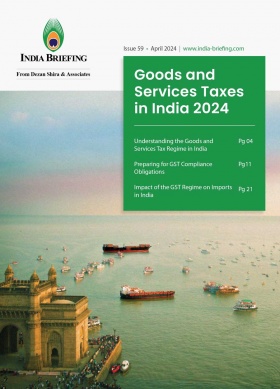India’s Trade Performance in FY 2023-24 and Strategy to Explore New Export Markets
We discuss India’s trade performance in FY 2023-24 and the strategy to overcome the trade deficit by penetrating new export markets for its commodities and value-added products.
India has released its latest trade data, forecasting that export figures will sustain the peak achieved in the previous year, reaching an estimated US$776.68 billion in the fiscal year (FY) 2023–24, slightly surpassing the US$776.40 billion recorded in the preceding fiscal year. According to the Ministry of Commerce and Industry, FY24 concluded with the highest monthly merchandise exports of the fiscal year, totaling US$41.68 billion in March 2024.
Total goods imports by India in 2023–24 decreased by 5.66 percent to US$675.44 billion.
Looking ahead, India is actively working on expanding its export portfolio beyond traditional sectors like iron ore and agricultural commodities. The focus is on diversifying into electronics, pharmaceuticals, engineering products, and food items. The Ministry of Commerce’s initiative aims to strengthen export offerings by introducing goods such as alcohol beverages, prepared meals, confectioneries, and value-added products like jackfruit and bananas.
To tailor products to the preferences and legal requirements of each target market, the commerce ministry’s strategy will entail thorough market research and analysis.
India’s trade performance in FY 2023-24
Trade during FY 2023-24 (April 1, 2023 to March 31, 2024) *
|
Export/import |
2023-24 (US$ billion) |
2022-23 (US$ billion) |
|
|
Merchandise |
Export |
437.06 |
451.07 |
|
Import |
677.24 |
751.97 |
|
|
Services |
Export |
339.62 |
325.33 |
|
Import |
177.56 |
182.05 |
|
|
Overall trade (merchandise+services) * |
Export |
776.68 |
776.40 |
|
Import |
854.80 |
898.01 |
|
|
Trade balance |
-78.12 |
-121.62 |
Data provided by Ministry of Commerce and Industry
The information with (*) indicates that the values are an estimate and are subjected to revision after the Reserve Bank of India (RBI) releases trade data for FY 2023-24.
The 2023-24 trade data indicates that non-petroleum and non-gems and jewelry exports have seen a modest increase of 1.45 percent, rising from US$315.64 billion in FY 2022-23 to US$320.21 billion in FY 2023-24. Key drivers of merchandise export growth in FY24 were electronic goods, drugs & pharmaceuticals, engineering goods, iron ore, cotton yarn, fabrics, and made-ups, handloom products, ceramic products, and glassware.
China surpasses the US to become India’s largest trading partner
According to data from the economic think tank GTRI, China has emerged as India’s largest trading partner, surpassing the US, with two-way commerce totaling US$118.4 billion in FY 2023-24. In the same period, bilateral trade between India and the US amounted to US$118.3 billion. Previously, the US was India’s top trading partner in 2021-22 and 2022-23.
GTRI’s analysis shows that India’s exports to China experienced a notable increase of 8.7 percent in FY24, reaching US$16.67 billion. Key sectors driving this growth included iron ore, cotton yarn/fabrics/madeups, handloom products, spices, fruits and vegetables, as well as plastic and linoleum. Meanwhile, imports from China saw a moderate rise of 3.24 percent, totaling US$101.7 billion. Key import items included high-tech gear like telecom and smartphone parts, laptop and PCs, as well as industrial inputs such as plastic, iron and steel, and chemicals.
India top 15 trade partners for 2023-2024 (Apr 2023-Feb 2024) (Value in US$ million)
|
Rank |
Country/Region |
Export |
Import |
|
1 |
China |
15,102.42 |
93,997.58 |
|
2 |
USA |
70,000.96 |
37,637.14 |
|
3 |
United Arab Emirates |
31,618.56 |
43,129.60 |
|
4 |
Russia |
3,820.24 |
55,591.65 |
|
5 |
Saudi Arabia |
10,365.97 |
29,127.47 |
|
6 |
Singapore |
12,822.40 |
19,614.52 |
|
7 |
Iraq |
3,007.01 |
26,664.61 |
|
8 |
Indonesia |
5,576.05 |
21,478.16 |
|
9 |
Hong Kong |
7,743.86 |
18,479.46 |
|
10 |
Republic of Korea |
5,899.10 |
19,471.66 |
|
11 |
Netherland |
20,258.00 |
4,588.86 |
|
12 |
Germany |
8,856.10 |
14,944.24 |
|
13 |
Australia |
7,470.84 |
14,948.38 |
|
14 |
Switzerland |
1,236.59 |
20,460.29 |
|
15 |
Japan |
4,684.08 |
15,984.85 |
Data Source: Department of Commerce
Conversely, Indian exports to the US witnessed a slight decrease of 1.32 percent, amounting to US$77.5 billion in FY24, compared to US$78.54 billion in 2022–23. Additionally, imports from the US declined by approximately 20 percent, settling at US$40.8 billion, as indicated by the data.
Based on data from the commerce ministry, China held the position of India’s primary trading partner from 2013-14 to 2017-18, and then again in 2020-21. Prior to China’s dominance, the UAE occupied the top spot as India’s largest trading partner. However, in FY24, the UAE ranked third with a trade volume of US$83.6 billion. Following closely were Russia with US$65.7 billion, Saudi Arabia with US$43.4 billion, and Singapore with US$35.6 billion in trade with India.
In FY24, imports from India’s key free trade agreement (FTA) partners (South Korea, Japan, Australia, UAE, Mauritius, ASEAN, and SAFTA) exhibited a robust growth rate, outpacing the overall influx of goods into the country. Specifically, these imports saw an impressive increase of nearly 38 percent, reaching a total of US$187.92 billion. This growth rate surpassed the 31.4 percent jump in India’s total imports, which amounted to US$675.45 billion during the same period. India’s total outbound shipments to its FTA partners grew at a more subdued pace.
Climbing up the ladder of merchandise exports
India’s position among the world’s merchandise exporters has advanced from 19th to 17th place, with a marginal increase in its share from 1.70 percent in 2014 to 1.82 percent in 2023. India states that, despite global economic uncertainties, its exports have expanded to 115 countries out of a total of 238 destinations during the 2023-24 period.
These 115 export destinations, which represent 46.5 percent of India’s export portfolio, include key markets such as the US, UAE, Netherlands, China, UK, Saudi Arabia, Singapore, Bangladesh, Germany, and Italy.
While the country’s overall merchandise exports experienced a 3 percent decline to US$437.1 billion in the previous fiscal year, services exports increased to US$341.1 billion in 2023-24, up from U$325.3 billion in 2022-23.
|
Top Sectors in Merchandise Trade FY 2023-24 (value in US$ million) |
|||
|
Export |
Growth/Degrowth |
Import |
Growth/Degrowth |
|
Iron Ore |
3913.85 (117.74%) |
Cotton Raw & Waste |
598.63 (-58.39%) |
|
Electronic Goods |
29121.26 (23.64%) |
Fertilizers, Crude & Manufactured |
10456.90 (-39.23%) |
|
Tobacco |
1449.55 (19.46%) |
Sulphur & Unroasted Iron Pyrites |
211.17 (-37.51%) |
|
Ceramic Products & Glassware |
4277.37 (14.44%) |
Vegetable Oil |
14871.65 (-28.63%) |
|
Fruits & Vegetables |
3653.31 (13.86%) |
Pearls, Precious & Semi-Precious Stones |
23831.88 (-22.37%) |
|
Meat, Dairy & Poultry Products |
4527.31 (12.34%) |
Coal, Coke & Briquettes, Etc. |
38886.93 (-21.81%) |
|
Spices |
4251.05 (12.3%) |
Organic & Inorganic Chemicals |
26710.73 (-20.13%) |
|
Coffee |
1286.29 (12.22%) |
Newsprint |
425.49 (-18.39%) |
|
Drugs & Pharmaceuticals |
27849.24 (9.67%) |
Project Goods |
1321.39 (-17.56%) |
|
Cereal Preparations & Miscellaneous Processed Items |
2852.29 (8.96%) |
Petroleum, Crude & Products |
179618.18 (-14.23%) |
|
Oil Seeds |
1437.02 (7.43%) |
Transport Equipment |
26937.03 (-14.02%) |
|
Handicrafts Excl. Hand Made Carpet |
1802.36 (6.74%) |
Textile Yarn Fabric, Made-Up Articles |
2277.85 (-12.98%) |
|
Cotton Yarn/Fabs./Made-Ups, Handloom Products Etc. |
11682.93 (6.71%) |
Pulp And Waste Paper |
1856.67 (-12.33%) |
Data by Ministry of Commerce and Industry
India seeking new exports markets
India’s Ministry of Commerce intends to promote iron ore exports to Kenya, Saudi Arabia, and France. Additionally, it has identified new markets for engineering items in Sao Tome, Macao, Georgia, and Croatia. For agricultural and processed food products, it has secured markets in Nigeria, Switzerland, and Lithuania, and for pharmaceuticals, it is exploring new markets such as Montenegro and South Sudan.
To support these initiatives, policy interventions are underway to strengthen ties with the processed food industry through the Agricultural and Processed Food Products Export Development Authority (APEDA). Additionally, the government is contemplating lifting bans on certain exports, such as wheat and rice, to further balance trade dynamics.
In September 2022, India had imposed a ban on the trading of broken rice, followed by a prohibition on wheat exports in May 2022. Effective July 20, 2023, exports of non-basmati rice were also prohibited. Regarding onions, a notification from the Directorate General of Foreign Trade (DGFT) in December 2023 introduced a minimum export price (MEP) of US$550 per tonne. Furthermore, on May 10, 2024, a 40 percent export tariff on staple vegetables was implemented, with onion shipments remaining banned for over six months.
Considering lifting the export ban on additional commodities could open up trading opportunities for India, potentially enhancing farmers’ income through crop diversification and promoting processed food products in global markets.
China market access for Indian companies
Acknowledging India’s concerns regarding its substantial trade deficit with China, the newly appointed Chinese ambassador, Xu Feihong, expressed Beijing’s willingness to address this issue by enabling more Indian enterprises to access the Chinese market.
In 2022, India’s trade deficit surpassed the US$100 billion mark, reaching US$101 billion for the first time. India has approached China to open up sectors such as IT, pharmaceuticals, and grains, which hold significant export potential for India.
The bilateral trade between India and China continues to be robust, with total trade reaching a record US$136.2 billion in 2023. India’s trade deficit decreased marginally to US$99.2 billion in 2023, from US$100 billion in 2022, according to data from China’s customs authorities.
China is reportedly prepared to assist Indian companies in meeting the demands of the Chinese market and exploring opportunities for commercial and trade collaboration. Xu noted that Chinese diplomatic missions in India issued nearly 190,000 visas in 2023, with over 80 percent being business visas, underscoring the importance of business travel for bilateral trade. Xu also said that China would offer more support for India’s participation in events like the China International Import Expo, the China-South Asia Expo, and the Canton Fair.
With inputs from Melissa Cyrill.
About Us
India Briefing is one of five regional publications under the Asia Briefing brand. It is supported by Dezan Shira & Associates, a pan-Asia, multi-disciplinary professional services firm that assists foreign investors throughout Asia, including through offices in Delhi, Mumbai, and Bengaluru in India. Dezan Shira & Associates also maintains offices or has alliance partners assisting foreign investors in China, Hong Kong SAR, Vietnam, Indonesia, Singapore, Malaysia, Mongolia, Dubai (UAE), Japan, South Korea, Nepal, The Philippines, Sri Lanka, Thailand, Italy, Germany, Bangladesh, Australia, United States, and United Kingdom and Ireland.
For a complimentary subscription to India Briefing’s content products, please click here. For support with establishing a business in India or for assistance in analyzing and entering markets, please contact the firm at india@dezshira.com or visit our website at www.dezshira.com.
- Previous Article India’s Construction Equipment Market to Become World’s 2nd Largest by 2030
- Next Article India Signs 10-Year Pact with Iran to Operate its Chabahar Port








